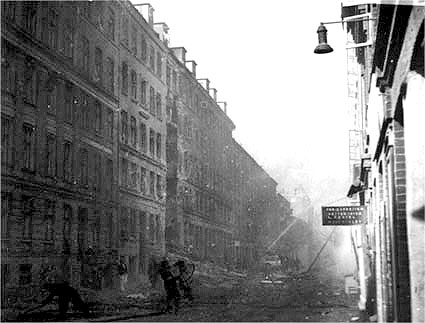Let me add to this based on the OP's question.
Could the US have built the Mosquito? Yes
I think under license Bellanca would be a perfect company for this based on their experience building wood aircraft.
Could the Mosquito have replaced the B-17 in a strategic role?
For some missions, yes but in the bigger picture no.
Bringing the Mosquito on line, getting a production license, signing contracts and building tooling would have taken at least 18 months if not longer. As mentioned earlier, General Arnold showed several manufacturers Mosquito drawings, no one wanted to touch it - but then again the AAC did not put up a solicitation for bid.
Could an "all-Mosquito" bomber force bring the same amount of destruction to Germany as the around the clock bombing by the RAF and USAAF did with 4 engine bombers?
IMO - No, however there were probably many applications where using the Mosquito "would have" been more efficient and effective.
Was the Strategic Bombing Campaign of Germany a complete failure?
Obviously not LOL! But in hindsight it could have been done more efficiently with less losses of airmen and aircraft.
Did the US "NEED" the Mosquito? Need no, "would have been nice to have" yes. As we know the Mosquito was used by the AAF as a night fighter and recon aircraft.
The Mosquito did show that in tactical and some strategic applications, the fast, low and precise fighter bomber can be more effective than the "bomb truck." Until the day of precision weapons and delivery systems came, you were still dropping unguided bombs. Everyone talks about mitigating civilian causalities but even with the most accurate bomber of the era, civilian causalities are going to happen.

Operation Carthage - Wikipedia
en.wikipedia.org
All reasonable, but it's a matter of scale. The heavy bomber campaign wasn't a "complete failure" but it could have been done much more effectively. Sometimes we just go with the momentum on something when it would have actually been wiser to change course. Inevitably civilian casualties are going to happen (we still see that with predators and hellfires or laser guided bombs) but that is a far cry from intentionally burning down a whole city.
There is also such a thing as continuing a particular strategy even when it's not showing results and is costing too much in friendly casualties. The 8th AF and US commanders showed the good sense to back off from the (partly) unescorted daylight bombing after Schweinfurt etc., and basically wait until improvements to the existing (P-38, P-47) escort fighters and the incredibly rapid run up of the new one (P-51) allowed them to continue deep penetration raids.
I am just suggesting something similar could have been done with the bombers, though it would have required a couple of true visionaries in the right places at the right time, and there is always a shortage of those. Luckily we had a few in place for the P-51 etc. And in the early development of the Mosquito itself.
